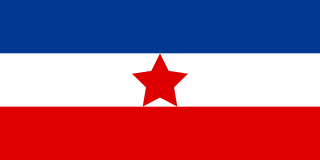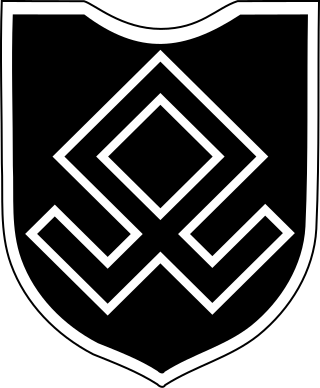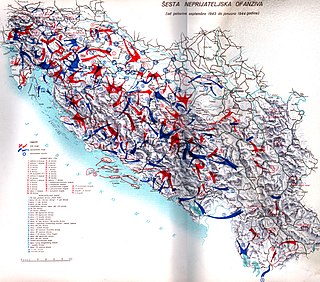Related Research Articles

The Balkans campaign of World War II began with the Italian invasion of Greece on 28 October 1940. In the early months of 1941, Italy's offensive had stalled and a Greek counter-offensive pushed into Albania. Germany sought to aid Italy by deploying troops to Romania and Bulgaria and attacking Greece from the east. Meanwhile, the British landed troops and aircraft to shore up Greek defences. A coup d'état in Yugoslavia on 27 March caused Adolf Hitler to order the conquest of that country.

The Yugoslav Partisans, or the National Liberation Army, officially the National Liberation Army and Partisan Detachments of Yugoslavia, was the communist-led anti-fascist resistance to the Axis powers in occupied Yugoslavia during World War II. Led by Josip Broz Tito, the Partisans are considered to be Europe's most effective anti-Axis resistance movement during World War II.

Case Black, also known as the Fifth Enemy Offensive in Yugoslav historiography and often identified with its final phase, the Battle of the Sutjeska was a joint attack by the Axis taking place from 15 May to 16 June 1943, which aimed to destroy the main Yugoslav Partisan force, near the Sutjeska river in south-eastern Bosnia. The failure of the offensive marked a turning point for Yugoslavia during World War II. It was also the last major German-Italian joint operation against the partisans.

The 7th SS Volunteer Mountain Division "Prinz Eugen", initially named the SS-Volunteer Division Prinz Eugen, was a mountain infantry division of the Waffen-SS, an armed branch of the German Nazi Party that served alongside but was never formally part of the Wehrmacht during World War II. At the post-war Nuremberg trials, the Waffen-SS was declared to be a criminal organisation due to its major involvement in war crimes and crimes against humanity. From 1942 to 1945, the division fought a counter-insurgency campaign against communist-led Yugoslav Partisan resistance forces in occupied Yugoslavia. It was formed in 1941 from both Reich Germans and Volksdeutsche – ethnic German volunteers and conscripts from the Banat, Independent State of Croatia, Hungary and Romania. The division surrendered on 11 May 1945 to Yugoslav Partisan forces, with thousands of stragglers surrendering by the 15th near the Austrian border.

Operation Southeast Croatia was a large-scale German-led counter-insurgency operation conducted in the southeastern parts of the Independent State of Croatia during World War II. It was the first of two German-led operations targeting mainly Yugoslav Partisans in eastern Bosnia between 15 January and 4 February 1942. Several days after the conclusion of Operation Southeast Croatia, a follow-up operation known as Operation Ozren was carried out between the Bosna and Spreča rivers. Both operations also involved Croatian Home Guard and Italian troops and are associated with what is known as the Second Enemy Offensive in post-war Yugoslav historiography. The Second Enemy Offensive forms part of the Seven Enemy Offensives framework in Yugoslav historiography.

Operation Trio was the first large-scale joint German-Italian counter-insurgency operation of World War II conducted in the Independent State of Croatia (NDH), which included modern-day Bosnia and Herzegovina. It was carried out in two phases within eastern Bosnia from 20 April to 13 May 1942, with Ustaše militia and Croatian Home Guard forces taking part on the Axis side. The aim of the operation was to target all insurgents between Sarajevo and the Drina river in eastern Bosnia. These included the communist-led Yugoslav Partisans and Serb nationalist Chetniks. Differentiating between the rank and file of the two insurgent factions was difficult, as even the communist-led insurgent groups consisted mainly of Serb peasants who had little understanding of the political aims of their leaders.
The Seven Enemy Offensives is a group name used in Yugoslav historiography to refer to seven major Axis military operations undertaken during World War II in Yugoslavia against the Yugoslav Partisans.

World War II in the Kingdom of Yugoslavia began on 6 April 1941, when the country was invaded and swiftly conquered by Axis forces and partitioned among Germany, Italy, Hungary, Bulgaria and their client regimes. Shortly after Germany attacked the USSR on 22 June 1941, the communist-led republican Yugoslav Partisans, on orders from Moscow, launched a guerrilla liberation war fighting against the Axis forces and their locally established puppet regimes, including the Axis-allied Independent State of Croatia (NDH) and the Government of National Salvation in the German-occupied territory of Serbia. This was dubbed the National Liberation War and Socialist Revolution in post-war Yugoslav communist historiography. Simultaneously, a multi-side civil war was waged between the Yugoslav communist Partisans, the Serbian royalist Chetniks, the Axis-allied Croatian Ustaše and Home Guard, Serbian Volunteer Corps and State Guard, Slovene Home Guard, as well as Nazi-allied Russian Protective Corps troops.

The Italian governorate of Montenegro existed from October 1941 to September 1943 as an occupied territory under military government of Fascist Italy during World War II. Although the Italians had intended to establish a quasi-independent Montenegrin kingdom, these plans were permanently shelved after a popular uprising in July 1941. Following the Italian surrender in September 1943, the territory of Montenegro was occupied by German forces which withdrew in December 1944.

Pavle Đurišić was a Montenegrin Serb regular officer of the Royal Yugoslav Army who became a Chetnik commander (vojvoda) and led a significant proportion of the Chetniks in Montenegro during World War II. He distinguished himself and became one of the main commanders during the popular uprising against the Italians in Montenegro in July 1941, but later collaborated with the Italians in actions against the Communist-led Yugoslav Partisans. In 1943, his troops carried out several massacres against the Muslim population of Bosnia, Herzegovina, and the Sandžak in which an estimated 10,000 people were killed between January and March, including thousands of women, children, and the elderly. He then led his troops during their participation in the anti-Partisan Case White offensive alongside Italian forces. Đurišić was captured by the Germans in May 1943, escaped, and was recaptured.

During the Second World War, resistance movements that bore any resemblance to irregular warfare were frequently dealt with by the German occupying forces under the auspices of anti-partisan warfare. In many cases, the Nazis euphemistically used the term "anti-partisan operations" to obfuscate ethnic cleansing and ideological warfare operations against perceived enemies; this included Jews, Communist officials, Red Army stragglers, and others. This was especially the case on the Eastern Front, where anti-partisan operations often resulted in the massacres of innocent civilians. While the worst atrocities in terms of scale occurred in the Eastern theater of the war, the Nazis employed "anti-partisan" tactics in Western Europe as well.

Petar Baćović was a Bosnian Serb Chetnik commander within occupied Yugoslavia during World War II. From the summer of 1941 until April 1942, he headed the cabinet of the Ministry of Internal Affairs for Milan Nedić's puppet Government of National Salvation in the German-occupied territory of Serbia. In May and June 1942, Baćović participated in the joint Italian-Chetnik offensive against the Yugoslav Partisans in Montenegro. In July 1942, Baćović was appointed by the Chetnik leader Draža Mihailović and his Supreme Command as the commander of the Chetnik units in the regions of eastern Bosnia and Herzegovina within the Axis puppet state, the Independent State of Croatia. In this role, Baćović continued collaborating with the Italians against the Yugoslav Partisans, with his Chetniks formally recognised as Italian auxiliaries from mid-1942.

Lieutenant Colonel Zaharije Ostojić was a Montenegrin Serb and Yugoslav military officer who served as the chief of the operational, organisational and intelligence branches of the Chetnik Supreme Command led by Draža Mihailović in Yugoslavia during World War II. He was a major in the Royal Yugoslav Army Air Force prior to the Axis invasion of Yugoslavia, and was involved in the coup that deposed Prince Paul of Yugoslavia on 27 March 1941. After the coup, he escorted Prince Paul to exile in Greece, and was in Cairo during the invasion in April. In September 1941, he was landed on the coast of the Italian governorate of Montenegro along with the British Special Operations Executive officer Captain Bill Hudson and two companions. He escorted Hudson to the German-occupied territory of Serbia and introduced him to the Yugoslav Partisan leader Josip Broz Tito at Užice, then accompanied Hudson to Ravna Gora to meet Mihailović. Ostojić soon became Mihailović's chief of staff, and after the German attempt to capture the Chetnik leader during Operation Mihailovic in December 1941, brought the Chetnik Supreme Command staff to Montenegro where they were re-united with Mihailović in June 1942. During the remainder of 1942, Ostojić launched a counter-attack against Ustaše troops of the Independent State of Croatia returning to the eastern Bosnian town of Foča where they were expected to continue their genocidal anti-Serb policies. As many as 2,000 local Muslims were subsequently killed in the town by forces under Ostojić's command. Ostojić later oversaw large-scale massacres of civilians and burning of Muslim villages in the border region between Montenegro and the Sandžak.

The 342nd Infantry Division was a formation of the German Wehrmacht during World War II. Established on 19 November 1940, it was formed from elements of two existing divisions. It first served as part of the occupation forces in France between June and September 1941 and was then largely responsible for the brutal repression of resistance in eastern parts of Axis-occupied Yugoslavia between September 1941 and February 1942.

The Uprising in Montenegro, commonly known as the 13 July Uprising was an uprising against Italian occupation forces in Montenegro. Initiated by the Communist Party of Yugoslavia on 13 July 1941, it was suppressed within six weeks, but continued at a much lower intensity until Battle of Pljevlja on 1 December 1941. The insurgents were led by a combination of communists and former Royal Yugoslav Army officers from Montenegro. Some of the officers had recently been released from prisoner-of-war camps following their capture during the invasion of Yugoslavia. The communists managed the organisation and provided political commissars, while the insurgent military forces were led by former officers. The entire nation rejected the privileged position offered by its occupiers, rejected the capitulation in order to fight for Yugoslavia, together with "Russia".
Leftist errors was a term used by the Communist Party of Yugoslavia (CPY) to describe radical policies and strategies – described as the Red Terror by others – pursued by self-described left-wing elements among the party and partisan units during World War II, mostly in Montenegro, Herzegovina, and Serbia, as well as to a lesser extent in Croatia and Slovenia.

The Battle of Pljevlja, was a World War II attack in the Italian governorate of Montenegro by Yugoslav Partisans under the command of General Arso Jovanović and Colonel Bajo Sekulić, who led 4,000 Montenegrin Partisans against the Italian occupiers in the town of Pljevlja.

Đorđije Lašić was a Montenegrin Serb military officer of the Royal Yugoslav Army. During the Second World War he participated in the 1941 Uprising in Montenegro, but has soon turned to collaboration with Axis occupation forces until 1944, when he was killed during the bombing of Podgorica.

The 1942 Montenegro offensive was an Italian-led counter-insurgency operation of World War II, which targeted the Yugoslav Partisans in the Italian governorate of Montenegro and the eastern Herzegovina region of the Independent State of Croatia (NDH). It was carried out from mid-May to June 1942, with Chetnik forces taking part on the Italian side. The offensive followed the conclusion of the joint German-Italian Operation Trio in eastern Bosnia. Together these two operations comprise what was known as the Third Enemy Offensive in Yugoslav historiography.

The Partisan Long March was the redeployment of Josip Broz Tito's Partisan Supreme Headquarters and the major fighting elements of the Yugoslav Partisans across the Independent State of Croatia, from south-eastern to north-western Bosnia that commenced in late June 1942. The march followed the first large-scale joint German-Italian counter-insurgency operation in the NDH, Operation Trio, and the combined Italian-Montenegrin Chetnik offensive in Montenegro and eastern Herzegovina.
References
- ↑ Ramet, Sabrina P. (6 June 2006). The Three Yugoslavias: State-Building and Legitimation, 1918-2005. Indiana University Press. p. 153. ISBN 978-0-253-34656-8.
- ↑ Tomasevich, Jozo (October 2002). War and Revolution in Yugoslavia, 1941-1945: Occupation and Collaboration. Stanford University Press. p. 414. ISBN 978-0-8047-7924-1.